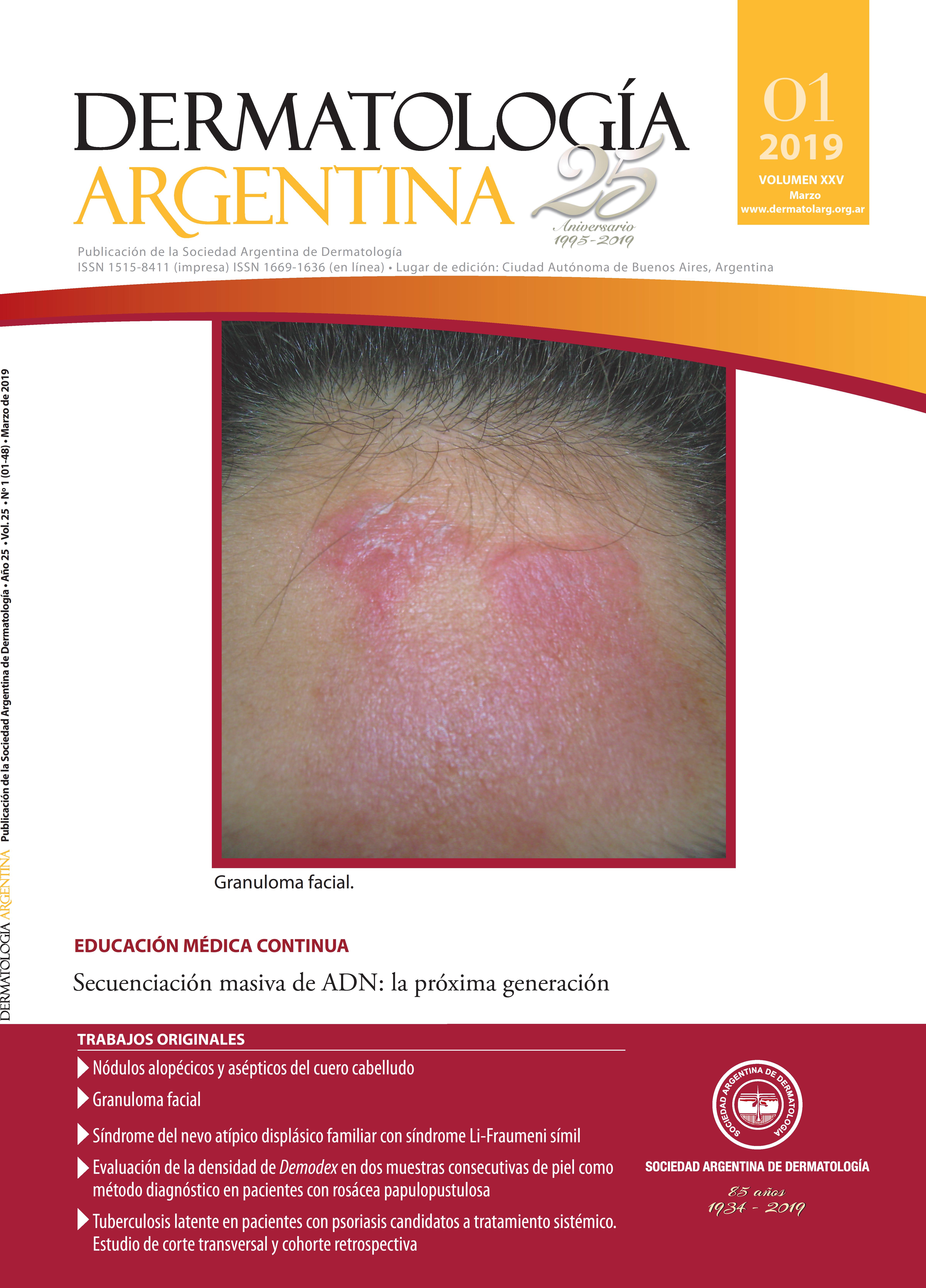Two consecutive standardized skin surface biopsy to evaluate Demodex density as a diagnostic tool for patients with papulopustular rosacea
Keywords:
Demodex, rosacea, standardized skin surface biopsyAbstract
Background: The prevalence of Demodex folliculorum in patients with rosacea pustular papule (RPP) was reported to be between 55-74%. Both the Standardized Skin Surface Biopsy (SSSB) and dermatoscopy are non-invasive diagnostic tools and simple to perform in the dermatological consultation.
Objectives: The objective was to evaluate whether dermatoscopy and taking two consecutive SSSB are useful for the evaluation of Demodex density in patients with PPR.
Methods: We included those patients over 18 and under 90 years old, attended in our service with PPR diagnosis, during the period between September and December 2017. Two consecutive SSSB were taken in two types of areas previously classified by dermatoscopy as suggestive or non-suggestive of Demodex. Detection of > 5 Demodex/field in the first take or > 10 Demodex/field in the second was considered positive SSSB.
Results: A total of 39 patients were evaluated. The most frequent suggestive area was the cheek (87.18%) and the non-suggestive area was the forehead (69.23%). The first sample was positive in 20 patients (51.28%) iin the area with suggestive dermatoscopy and 7 (17.95%) in the non-suggestive area. When the second consecutive dose was taken, only 2 patients, per group, could be recategorized as Demodex positive, finally obtaining 22 (56.41%) patients with positive results in areas with suggestive dermatoscopy and 9 (23.08%) in non-suggestive areas.
Conclusions: The performance of two SSSB increased the diagnostic revenue for the detection of Demodex. Dermatoscopy may be complementary to MSEP.
References
I. Erbagci Z, Ozgoztasi O. The significance of Demodex folliculorum density in rosacea. Int J Dermatol 1998;37:421-425.
II. Forton F, Germaux MA, Brasseur T, De Liever A, et ál. Demodicosis and rosacea: epidemiology and significance in daily dermatological practice. J Am Acad Dermatol 2005;52:74-87.
III. Litwin D, Chen WC, Dzika E, Korycińska J. Human permanent Ectoparasites; recent advances on biology and clinical significance of Demodex mites: narrative review articles. Iran J Parasitol 2017;12:12-21.
IV. Forton F, Seys B. Density of Demodex folliculorum in rosacea: a case control study using standardized skin surface biopsy. Br J Dermatol 1993;128:650-659.
V. Forton F, De Maertelaer V. Two consecutive standardized skin surface biopsies: an improved sampling method to evaluate Demodex density as a diagnostic tool for rosacea and demodicosis. Acta Derm Venereol 2017;97:242-248.
VI. Segal R, Mimouni D, Feuerman H, Pagovitz O, et ál. Dermoscopy as a diagnostic tool in demodecidosis. Int J Dermatol 2010;9:1018-1023.
VII. Sattler EC, Maier T, Hoffmann VS, Hegyi J, et ál. Non-invasive in vivo detection and quantification of Demodex mites by confocal laser scanning microscopy. Br J Dermatol 2012;62:1050-1052.
VIII. Aytekin S, Göktay S, Yaşar Ş, Gizlenti S, et ál. Tips and tricks on Demodex density examination by standardized skin surface biopsy. J Eur Acad Dermatol Venereol 2016;30:e126-e127.
IX. Yun CH, Yun JH, Ok Baek J, Roh JY, et ál. Demodex mite density determinations by standardized skin surface biopsy and direct microscopic examination and their relations with clinical types and distribution patterns. Ann Dermatol 2017;29:137-141.
X. Hsu C, Hsu M, Lee J. Demodicosis: a clinicopathological study. J Am Acad Dermatol 2009;60:453-462.
XI. Aşkin U, Seçkin D. Comparison of the two techniques for the measurement of the density of Demodex folliculorum: standardized skin surface biopsy and direct microscopic examination. Br J Dermatol 2010;162:1124-1126.
XII. Forton F, Song M. Limitations of standardized skin surface biopsy in measurement of the density of Demodex folliculorum. A case report. Br J Dermatol 1998;139:697-700.
XIII. Zeytun E, Tilki E, Doğan S, Mumcuoğlu KY, et ál. The effect of skin moisture, pH, and temperatura on the density of Demodex folliculorum and Demodex brevis (Acari: demodicidae) in students and staff of the Erzincan University, Turkey. Int J Dermatol 2017;56:762-766.
XIV. Lallas A, Argenziano G, Longo C, Moscarella E, et ál. Polygonal vessels of rosacea are highlighted by dermoscopy. Int J Dermatol 2013;53:e325-327.
XV. Friedman P, Cohen Sabban E, Cabo H. Usefulness of dermoscopy in the diagnosis and monitoring treatment of demodecidosis. Dermatol Pract Concept 2017;7:35-38.
Downloads
Published
Issue
Section
License
El/los autor/es tranfieren todos los derechos de autor del manuscrito arriba mencionado a Dermatología Argentina en el caso de que el trabajo sea publicado. El/los autor/es declaran que el artículo es original, que no infringe ningún derecho de propiedad intelectual u otros derechos de terceros, que no se encuentra bajo consideración de otra revista y que no ha sido previamente publicado.
Le solicitamos haga click aquí para imprimir, firmar y enviar por correo postal la transferencia de los derechos de autor












